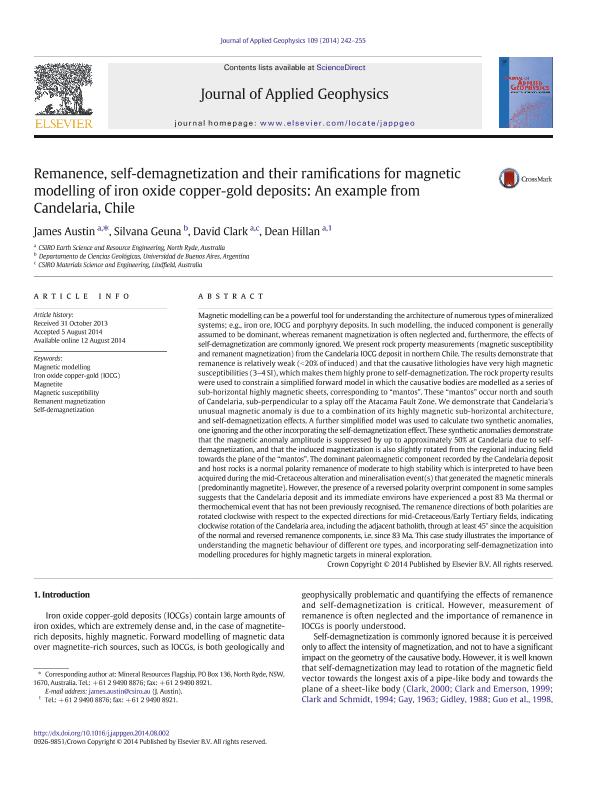Mostrar el registro sencillo del ítem
dc.contributor.author
Austin, James

dc.contributor.author
Geuna, Silvana Evangelina

dc.contributor.author
Clark, David

dc.contributor.author
Hillan, Dean

dc.date.available
2017-07-10T18:47:45Z
dc.date.issued
2014-10
dc.identifier.citation
Austin, James; Geuna, Silvana Evangelina; Clark, David; Hillan, Dean; Remanence, self-demagnetization and their ramifications for magnetic modelling of iron oxide copper-gold deposits: An example from Candelaria, Chile; Elsevier Science; Journal Of Applied Geophysics; 109; 10-2014; 242-255
dc.identifier.issn
0926-9851
dc.identifier.uri
http://hdl.handle.net/11336/20016
dc.description.abstract
Magnetic modelling can be a powerful tool for understanding the architecture of numerous types of mineralized systems; e.g., iron ore, IOCG and porphyry deposits. In such modelling, the induced component is generally assumed to be dominant, whereas remanent magnetization is often neglected and, furthermore, the effects of self-demagnetization are commonly ignored. We present rock property measurements (magnetic susceptibility and remanent magnetization) from the Candelaria IOCG deposit in northern Chile. The results demonstrate that remanence is relatively weak (b20% of induced) and that the causative lithologies have very high magnetic susceptibilities (3–4 SI), which makes them highly prone to self-demagnetization. The rock property results were used to constrain a simplified forward model in which the causative bodies are modelled as a series of sub-horizontal highly magnetic sheets, corresponding to “mantos”. These “mantos” occur north and south of Candelaria, sub-perpendicular to a splay off the Atacama Fault Zone. We demonstrate that Candelaria's unusual magnetic anomaly is due to a combination of its highly magnetic sub-horizontal architecture, and self-demagnetization effects. A further simplified model was used to calculate two synthetic anomalies, one ignoring and the other incorporating the self-demagnetization effect. These synthetic anomalies demonstrate that the magnetic anomaly amplitude is suppressed by up to approximately 50% at Candelaria due to selfdemagnetization, and that the induced magnetization is also slightly rotated from the regional inducing field towards the plane of the “mantos”. The dominant paleomagnetic component recorded by the Candelaria deposit and host rocks is a normal polarity remanence of moderate to high stability which is interpreted to have been acquired during the mid-Cretaceous alteration and mineralisation event(s) that generated the magnetic minerals (predominantly magnetite). However, the presence of a reversed polarity overprint component in some samples suggests that the Candelaria deposit and its immediate environs have experienced a post 83 Ma thermal or thermochemical event that has not been previously recognised. The remanence directions of both polarities are rotated clockwise with respect to the expected directions for mid-Cretaceous/Early Tertiary fields, indicating clockwise rotation of the Candelaria area, including the adjacent batholith, through at least 45° since the acquisition of the normal and reversed remanence components, i.e. since 83 Ma. This case study illustrates the importance of understanding the magnetic behaviour of different ore types, and incorporating self-demagnetization into modelling procedures for highly magnetic targets in mineral exploration.
dc.format
application/pdf
dc.language.iso
eng
dc.publisher
Elsevier Science

dc.rights
info:eu-repo/semantics/openAccess
dc.rights.uri
https://creativecommons.org/licenses/by-nc-sa/2.5/ar/
dc.subject
Magnetic Modelling
dc.subject
Iron Oxide Copper Gold
dc.subject
Magnetite
dc.subject
Magnetic Susceptibility
dc.subject.classification
Geoquímica y Geofísica

dc.subject.classification
Ciencias de la Tierra y relacionadas con el Medio Ambiente

dc.subject.classification
CIENCIAS NATURALES Y EXACTAS

dc.title
Remanence, self-demagnetization and their ramifications for magnetic modelling of iron oxide copper-gold deposits: An example from Candelaria, Chile
dc.type
info:eu-repo/semantics/article
dc.type
info:ar-repo/semantics/artículo
dc.type
info:eu-repo/semantics/publishedVersion
dc.date.updated
2017-07-10T16:20:38Z
dc.journal.volume
109
dc.journal.pagination
242-255
dc.journal.pais
Países Bajos

dc.journal.ciudad
Amsterdam
dc.description.fil
Fil: Austin, James. Commonwealth Scientific and Industrial Research Organisation; Australia
dc.description.fil
Fil: Geuna, Silvana Evangelina. Consejo Nacional de Investigaciones Científicas y Técnicas. Oficina de Coordinación Administrativa Ciudad Universitaria. Instituto de Geociencias Basicas, Aplicadas y Ambientales de Buenos Aires. Universidad de Buenos Aires. Facultad de Ciencias Exactas y Naturales. Instituto de Geociencias Basicas, Aplicadas y Ambientales de Buenos Aires; Argentina
dc.description.fil
Fil: Clark, David. Commonwealth Scientific and Industrial Research Organisation; Australia
dc.description.fil
Fil: Hillan, Dean. Commonwealth Scientific and Industrial Research Organisation; Australia
dc.journal.title
Journal Of Applied Geophysics

dc.relation.alternativeid
info:eu-repo/semantics/altIdentifier/doi/http://dx.doi.org/10.1016/j.jappgeo.2014.08.002
dc.relation.alternativeid
info:eu-repo/semantics/altIdentifier/url/http://www.sciencedirect.com/science/article/pii/S0926985114002390
Archivos asociados
